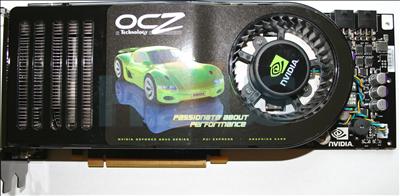OCZ GeForce 8800 GTX appearance and thoughts
OCZ brings nothing new to the table in terms of card design. The improvements, the company says, are centred on selecting only the finest speed-binned G80 cores from NVIDIA's manufacturing partner and premium-grade memory that's begging to be overclocked. We'll put those assertions to the test later but, on first glance, this could be any partners' board; all you have to do is remove the sticker and place your own - the PCBs are all identical. Underlining this fact is the knowledge that OCZ ships its card at default 'GTX clocks, that is, 575MHz core, 1350MHz shader, and 1800MHz GDDR3 memory.
We, however, removed the gargantuan heatsink after testing was completed and found that, as we suspected, OCZ is using the same Samsung K4J52324QE-BJ1A RoHS-certified memory as practically every other 8800 GTX card vendor. Interesting.
The side-on look shows the excellent reference cooler that's aided by a heatpipe design. We've said it many times before and feel that it's worth repeating: this is the best reference air-cooler we've seen thus far, keeping a high-wattage GPU cooled with the minimum of noise.
Of course, it's double-width and won't fit into smaller chassis with room limited to single-slot graphics, but most users thinking of high-end graphics will have adequate room in their cases to house this monster of a card, measuring almost a foot long. Take note, Subway!
A look at the other side shows how two, or more, cards can be connected to form a multi-GPU setup that has no current peer. You may need to be on friendly terms with your bank manager, however. Two of these cards will set you back around £800, and that's not including a possible PSU upgrade that will punch another hole in your wallet to the sum of £100 or so.
The power required for a GeForce 8800 GTX card is delivered by a combination of the PCIe x16 slot and two PEG connectors you see in the above picture. Going at full chat the range-topping G80 card can consume in excess of 200W. Off, now, at a complete tangent, that's the kind of wattage an intermediate cyclist puts out to the rear hub. You'd need a fit-again Lance Armstrong to power SLI.
VIVO support has gone the way of the dodo. Both DVI ports are dual-link and HDCP compliant, however.














